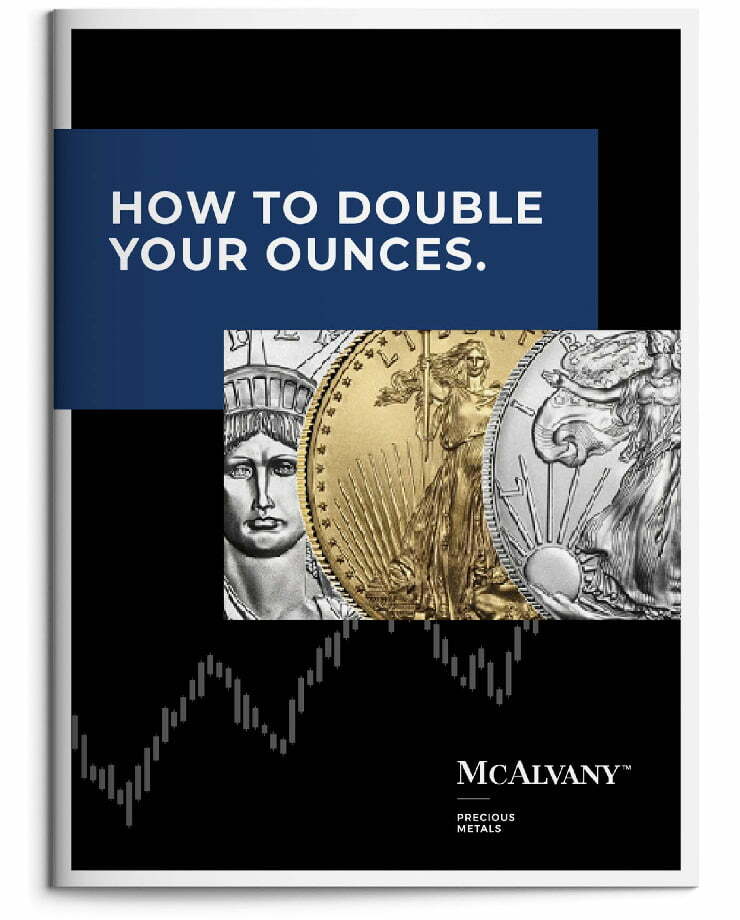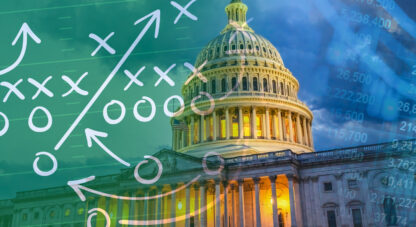Tariff Tennis, Capital Wars, and Gold’s Golden Decade
This was an interesting week at the increasingly busy intersection of Washington and Wall Street. First, Trump administration 2.0 was back on the offensive in the tariff trade war after targeting the EU for 50% duties that Trump claimed weren’t just a negotiating tactic.
Then, with a Wednesday curve ball, A U.S. federal court of International Trade ruled unanimously to strike down most of Trump’s new tariffs. The court ruled that the International Emergency Economic Powers Act (IEEPA) “does not authorize the President to impose unbounded tariffs.” Subject to appeal, this nullified all the tariffs imposed by the administration under that authority. These include all the “reciprocal” tariffs announced on April 2 (including the 10% baseline that was still in effect until Wednesday), as well as the 25% tariffs on Canada and Mexico and 20% duties on China related to border crossings and fentanyl traffic.
Now, before concluding that Wednesday was the official end of the global trade war, understand that there were further developments. By Thursday afternoon, news broke that the U.S. Court of Appeals for the Federal Circuit temporarily paused the ruling against President Trump’s global tariffs by the U.S. Court of International Trade, saying the ruling is “temporarily stayed until further notice while this court considers the motion’s papers.”
In consequence, the suddenly iced trade war is back to a hot war while we wait for a final decision from the U.S. Court of Appeals.
The back-and-forth tariff-tennis action this week conjured thoughts of Ferris Bueller observing that, “Life moves pretty fast. If you don’t stop and look around once in a while, you could miss it.” Except this week there was no time to stop and look around.
Summing it all up, HAI contends that the most important takeaway from the Trump trade war’s first tangle with the courts is that, regardless of the final ruling by the Court of Appeals, while the law could slow the Trump administration trade war, the law cannot stop it.
That’s because while the IEEPA may not give Trump the authority to impose sweeping tariffs, other statutes do.
In fact, in its ruling the trade court specifically named two other statutes—section 122 and section 301 of the Trade Act of 1974—that could be used to impose tariffs on the grounds of “large and serious balance-of-payments deficits” (section 122) or “unfair trade practices” (section 301). In other words, the court didn’t say Trump can’t impose tariffs, it just said the Trump administration needs to impose them under different legal authorities.
Now the previously stated potential for a slowing of the trade war arises from the fact that Section 301 tariffs are directed at countries guilty of unfair trade practices, and so first require an investigation by the U.S. Trade Representative—often a slow process.
That said, China has already been subjected to a 301 investigation, which means 301 tariffs could be imposed on China relatively quickly.
Section 122 tariffs are intended to address trade imbalances and do not require an investigation, and hence, wouldn’t slow the tariff process. But Section 122 tariffs come with limits. They max out at 15% and expire after 150 days without approval and extension by Congress.
The bottom line is that this week’s court ruling could slow the imposition of Trump’s tariffs, it could possibly (but unlikely) limit them, but it can’t outright stop them. The president has too many ways to impose tariffs, if he wishes, for the courts to ultimately stand in his way. As a result, despite the flurry of trade-related activity this week, the trade war—with its consequent policy and market uncertainty—is by no means over.
In fact, this week introduced the possibility that Trump’s war to “rebalance” the global system may be ready to expand to a second front. We already have a global trade war, but a global capital war may be next—and it certainly could get messy.
That’s why this week, while everyone else was watching trade war developments, Deutsche Bank’s policy team was focused instead on Section 899 of the “Big Beautiful Bill” (BBB) that is currently making its way through the U.S. Senate.
There remains plenty of uncertainty on the exact applicability of the new Section 899 legislation, but the overall interpretation is that it provides the U.S. government the ability to tax U.S.-sourced foreign income under certain conditions. Especially notable is that the foreign government tax exception put in place under Reagan (think central bank reserve ownership of U.S. Treasuries) would be suspended. If it’s voted through, Section 899 effectively introduces the most wide-ranging adverse changes to the tax treatment of foreign capital in the U.S. since the Deficit Reduction Act of 1984 and the Foreign Investors Tax Act of 1966.
According to Deutsche Bank, Section 899 challenges the open nature of US capital markets by explicitly using taxation on foreign holdings of U.S. assets as leverage to further U.S. economic goals. In other words, Section 899 of the BBB could legally weaponize U.S. capital markets to disincentivize foreign holdings of U.S. assets, including Treasuries, to weaken the dollar and thereby help revitalize U.S. manufacturing.
That notion rhymes quite well with what Trump’s head of his Council of Economic Advisors, Stephen Miran, suggested in November when he penned a report titled, “A User’s Guide to Restructuring the Global Trading System.” In it, Miran outlined potential policies that could result in a weaker dollar that might ultimately catalyze the MAGA goal of rebuilding and revitalizing the atrophied U.S. manufacturing base.
In A User’s Guide, Miran wrote that, “If the root cause of dollar overvaluation is demand for reserve assets, Treasury can make reserve accumulation less attractive. One way of doing this is to impose a user fee on foreign official holders of Treasury securities, for instance, withholding a portion of interest payments on those holdings.”
In the case of Section 899 of the BBB, a new 20% tax on U.S. sourced foreign investment income would be a different means of accomplishing the same goal. In HAI‘s view, if passed into law, this foreign tax in the BBB could represent a significant acceleration phase in the ongoing transition from U.S. Treasuries to gold as primary global reserve asset.
Stephen Miran agrees. In November, referring to policies that would disincentivize foreign hoarding of U.S. Treasuries as reserves, Miran said, “these policies may supercharge efforts of those looking to minimize exposure to the United States. Efforts to find alternatives to the dollar and dollar assets will intensify… alternative reserve assets like gold…will likely benefit.” HAI certainly agrees.
Meanwhile, also flying under the radar of the market’s trade war hyper-focus this week was a little-reported warning from the Bank for International Settlements (BIS). On Tuesday, Agustin Carstens, General Manager of the BIS, said that governments across the globe must curb their “relentless” rise in public debt, as higher interest rates make fiscal paths unsustainable. In HAI‘s view, Carstens is looking directly at you, America.
Now, before dismissing the BIS as a meaningless international organization, recall that the BIS acts as the central bank of national central banks. Further, it was the one organization that repeatedly warned—well ahead of time (and was ignored)—that policymakers were setting the table for the Great Financial Crisis (GFC).
On Tuesday, Carstens said, “the days of ultra-low rates are over. Fiscal authorities have a narrow window to put their house in order before the public’s trust in their commitments starts to fray… Markets are already waking up to the fact that some paths are not sustainable… That is why fiscal consolidation in many economies needs to start now. Muddling through is not enough.”
Just as in its warnings during the lead-up into the GFC, the BIS has been loudly singing this tune about unsustainable debt for well over a year (and again been ignored).
Crucially, however, HAI fears that, as in the pre-GFC era, the BIS warnings over runaway sovereign debt are already too late. Ominously, on May 22nd, Mr. DOGE himself, Elon Musk seemed to agree. Musk said, “I have come to the perhaps obvious conclusion that accelerating GDP growth is essential. DOGE has done great work to postpone the day of bankruptcy of America, but the profligacy of government means that only radical improvements in productivity can save our country.”
There is a lot to unpack in Musk’s statement, but for starters what’s ultimately identified as being at stake is “the day of bankruptcy of America.” Furthermore, the inconvenient truth lurking below the surface of Musk’s comment is that, while “accelerating GDP growth is essential” until a productivity miracle bails us out, we can’t currently accelerate GDP growth while cutting the government spending that is now responsible for a whopping 25% of GDP.
Increasingly, the signs appear to be mounting that the only way the U.S. will climb out of the debt trap is by inflating the debt away. That means we face growing risks of a perhaps silent policy decision to run inflation hot, stimulate GDP, and intervene to suppress bond yields.
Perhaps acknowledgement of the need to let inflation run hot, despite the Fed’s price stability mandate, is what this week’s Fed minutes were referring to in reporting that, “Fed officials saw potential for ‘difficult trade-offs’ ahead.”
In HAI‘s view, gold’s massive ascent ever higher into record price levels since early 2024 is confirmation that the BIS’s warnings about sovereign debt are all too accurate, but all too late. Inflating the debt away increasingly appears to be the last option for policymakers, and gold continues to win big in that scenario.
As commodity legend Rick Rule said this week, “To make a long story short, the only way that, politically, we can honor the nominal value of our obligations is to reduce the purchasing power of the US dollar. Traditionally, that has been very good for the gold price. In the decade of the 1970s… according to the congressional budget office, the purchasing power of the US dollar declined by 75% over 10 years. I think that is in front of us for the next 10 years… It makes absolute arithmetic sense that, if the purchasing power of the dollar declined by 75%, the gold price could go up in commensurate fashion.”
HAI agrees, and given expectations for a continuation of the uptrend in gold prices, the current opportunity in the gold mining stocks is truly remarkable. After all, according to HAI favorite commodity research firm Goehring & Rozencwajg, as of late May, gold mining stock valuations are still “among the lowest ever observed.”
HAI believes that, for so many reasons, we are currently in the middle of gold’s golden decade. Furthermore, HAI believes that at this present juncture of gold’s bull market, the performance torch is about to be definitively passed from physical gold to the gold equities. As HAI has said before, the miners now offer a truly exceptional opportunity for returns in a now-ripe set-up decades in the making.
Weekly performance: The S&P 500 was up 1.88%. Gold was down 2.07%, silver was off 1.43%, platinum was down 3.41%, and palladium was lower by 3.02%. The HUI gold miners index outperformed physical, holding nearly flat, up 0.10%. The IFRA iShares US Infrastructure ETF was up 0.77%. Energy commodities were volatile and mixed on the week. WTI crude oil was off 1.57%, while natural gas gained 4.56%. The CRB Commodity Index was down 2.10%. Copper was off 3.21%. The Dow Jones US Specialty Real Estate Investment Trust Index was up 2.25%. The Vanguard Utilities ETF was up 1.06%. The dollar index was up 0.22% to close the week at 99.33. The yield on the 10-yr U.S. Treasury was down 11 bps to close at 4.41%.
Have a wonderful weekend!
Best Regards,
Morgan Lewis
Investment Strategist & Co-Portfolio Manager
MWM LLC















